Ann Arbor’s Backlot
Welcome to Hollywood on the Huron! With Michigan’s ambitious film incentive package bringing movie sets to Ann Arbor, both U-M and the city have had to develop strategies for accommodating (and capitalizing) on their presence.
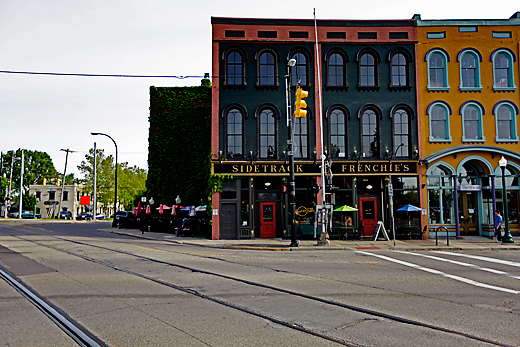 Ann Arbor is used to famous people but usually they”re of the pointy-headed, academic vein, book award winners and science academy scholar types. Lately, however, we”ve become ground zero for Hollywood celebrities. Filmmakers have discovered Ann Arbor numerous charms, securing parks, neighborhoods, downtown streets and, of course, U-M”s campus for shooting locations. Of course, we knew it all along: our tiny but mighty city has all the soul and low-key glam to be a filmmaker’s paradise.
Ann Arbor is used to famous people but usually they”re of the pointy-headed, academic vein, book award winners and science academy scholar types. Lately, however, we”ve become ground zero for Hollywood celebrities. Filmmakers have discovered Ann Arbor numerous charms, securing parks, neighborhoods, downtown streets and, of course, U-M”s campus for shooting locations. Of course, we knew it all along: our tiny but mighty city has all the soul and low-key glam to be a filmmaker’s paradise.
While past years saw a molasses flow of film projects, it took the aggressive Michigan Film Incentives of 2008 to attract a volume worth mentioning. Suddenly crews for feature films, television shows and commercials charged into town, cameras blazing. To accommodate them – and keep them coming back for more – the city and the formerly indifferent University of Michigan have formed special film offices, organized teams, made rules, and established protocols.
Two years in, and Ann Arbor has been basking in a validating influx of star power: Ed Norton jogging down Huron River Drive (the number of joggers along that strip of road increased for months after); Hilary Swank inquiring about classes at the Ann Arbor Y (attendance swelled); Minnie Driver (“that’s not her, Minnie Driver is not that tall”) and Paul Dano in the corner table at Eve; Catherine Keener lounging on the Diag; Colin Firth looking devastating just about anywhere; and the king of snakes on planes himself, Samuel L. Jackson. … the list is colorful, and varies with whomever you speak.
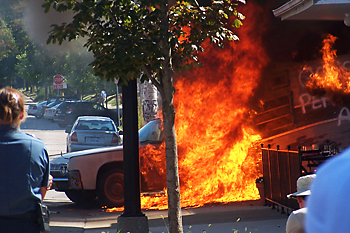 The incentive is generating stars’ interest in local offerings as well. Minnie Driver gave Tappan kids a pep talk. Amber Tamblyn and David Cross have made purchases at Ann Arbor’s Robot Supply and Repair Store of 826. Program Director Amy Summerton and an 826 volunteer later helped rescue Clive Owen and his family from a paparazzi ambush. “He bought some stuff for his kids, including a Fruit-Powered Clock,” said Somerton. “I let him out the back.”
The incentive is generating stars’ interest in local offerings as well. Minnie Driver gave Tappan kids a pep talk. Amber Tamblyn and David Cross have made purchases at Ann Arbor’s Robot Supply and Repair Store of 826. Program Director Amy Summerton and an 826 volunteer later helped rescue Clive Owen and his family from a paparazzi ambush. “He bought some stuff for his kids, including a Fruit-Powered Clock,” said Somerton. “I let him out the back.”
But this is not about creating a community of celebrity hounds. The concrete hope is that the money brought in by on-site film projects and the excitement generated by their presence can underpin economic recovery and stop the exodus of talented youth from Michigan’s cities. Leaders at the University of Michigan realized this quickly as a number of projects expressed interest in the campus, and they had only to look to New Mexico’s film incentive successes to see the potential upsides.
Maize and blue screen
“Until the incentive, we had occasional films on campus – but frankly we had avoided them,” explains University of Michigan Film Office Director Lee Doyle. “The tax incentive changed our mind because we are very much in support of new businesses and entrepreneurship.”
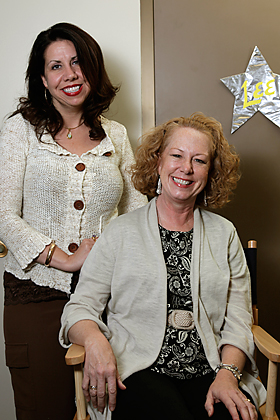 In response to interest for on-campus shoots, the University of Michigan established the University of Michigan Film Office. The office is led by Doyle and Associate Director Ann Zalucki, who helps with location management and logistics. Sometimes surprising things happen: in one film, Angel Hall became a sports arena. Rackham became a library. “It can be very interesting what they’re vision is in contrast to the reality. Even the Pfizer building has been used in movies, and will be again in the very near future for the film Salvation Boulevard, ” says Doyle.
In response to interest for on-campus shoots, the University of Michigan established the University of Michigan Film Office. The office is led by Doyle and Associate Director Ann Zalucki, who helps with location management and logistics. Sometimes surprising things happen: in one film, Angel Hall became a sports arena. Rackham became a library. “It can be very interesting what they’re vision is in contrast to the reality. Even the Pfizer building has been used in movies, and will be again in the very near future for the film Salvation Boulevard, ” says Doyle.
“We won’t do just any script – it has to not reflect on the university campus badly. For instance, a drunken fraternity prank and stuff like that,” she laughs. She does stress that her office tries to find a way to make it work whenever possible. What follows script and location approval is an intricate mesh of logistics meetings. Preparations like trailer parking, electricity, telephone lines, security and more must be made depending on where and when a film is shot, and even what is occurring in the scene.
For example, a night “brawl” shot on university property needed the university’s public safety department on hand for control, and specifically to prevent people coming out of nearby bars from misunderstanding the situation. “Of course – it’s pretty obvious, but you have to take precautions to make sure that they knew this was an action sequence and not a real brawl to join,” chuckles Doyle.
It’s not surprising that the University leaves nothing to chance, and Doyle and her team put students and their safety and education ahead of everything. Indeed, it is a priority never to disrupt or cancel classes. Filmmakers must also agree to a number of procedures and guidelines. In most cases they must also pay fees that vary by location, and purchase daily permits that range from $1,000 to $2,000, depending on whether the film is independent or studio-backed.
Student-made films get a break – while they still require the logistics and scene clearance provided by the Film Office, they don’t pay for fees or permits. Indeed, Doyle points out that one of the biggest reasons the University started accepting films is for the benefit of these film-oriented students. Many have even landed internships as production assistants and extras –simply because professional filmmakers often go to Doyle for workers. Doyle then contacts the School of Art and Design, the School of Music, and the School of Creative Studies, and makes the match.
Off campus, on set
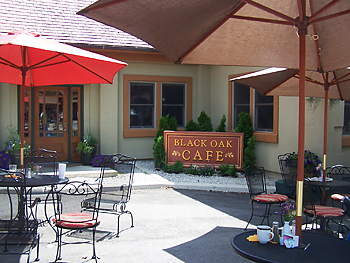 If you want to find out if Ann Arbor has the locations you need, or where your crew of 50 is going to stay every night, Kay Seaser of the Ann Arbor Area Film Office is your guide. Seaser acts as the logistical interface for prospective and existing film projects and the City of Ann Arbor. Like Doyle’s University office, Seaser’s department was founded in response to interest spurred by the 2008 tax incentives.
If you want to find out if Ann Arbor has the locations you need, or where your crew of 50 is going to stay every night, Kay Seaser of the Ann Arbor Area Film Office is your guide. Seaser acts as the logistical interface for prospective and existing film projects and the City of Ann Arbor. Like Doyle’s University office, Seaser’s department was founded in response to interest spurred by the 2008 tax incentives.
And it’s a good thing they were prepared. Between May 2008 and the end of 2009, Seaser worked with 14 different film projects, 11 of which were feature films. Eight had major names connected with them.
And it’s a good thing they were prepared. Between May 2008 and the end of 2009, Seaser worked with 14 different film projects, 11 of which were feature films. Eight had major names connected with them. Other Michigan communities have had to scramble when Hollywood came calling.
Being cooperative and facilitating the filmmaking process generates future business, says Seaser. “Often a location scout calls about our county because they have been referred by someone who was here last year.”
But word-of-mouth is not Ann Arbor’s only strategy. To educate filmmakers everywhere, Seaser’s office has joined the major film association AFCI (Association of Film Commissioners International) (http://www.afci.org/), attends trade shows and places ads in Variety magazine. “Our goal is to catch the attention of a filmmaker looking for something to fit their script, and to provide guidance as to where can they find, say, a school, a jail or a farmhouse. I then send them maps, photographs, and suggested locations.”
Once a filmmaker decides on Ann Arbor as a location, Seaser helps make the connections that will get them going — commercial and residential realtors for office and warehouse space, as well as upscale and mid-level long term housing. Small but crucial details like parking, communications, furniture rental, traffic and sidewalk permits, must be discussed and worked out.
The bottom line
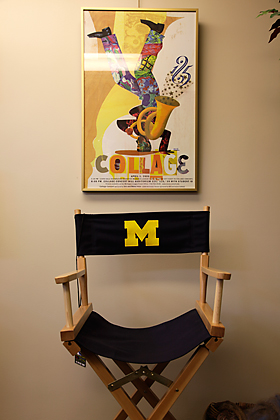 There are no definitive studies of the impact of the film industry on Ann Arbor – the industry is in its infancy after all – so estimates are difficult. Yet Seaser and her colleagues are optimistic based on the little they do know. Based on hotel room usage by movie productions in Ann Arbor, they have estimated a $6 million economic impact. Between 2008 and 2009 the movie industry generated approximately 25,000 room nights in Ann Arbor. That breaks down to just under 5,000 in 2008, and just over 20,000 in 2009.
There are no definitive studies of the impact of the film industry on Ann Arbor – the industry is in its infancy after all – so estimates are difficult. Yet Seaser and her colleagues are optimistic based on the little they do know. Based on hotel room usage by movie productions in Ann Arbor, they have estimated a $6 million economic impact. Between 2008 and 2009 the movie industry generated approximately 25,000 room nights in Ann Arbor. That breaks down to just under 5,000 in 2008, and just over 20,000 in 2009.
“There’s a lot spent that isn’t in that figure,” explains Seaser. “These film workers are buying groceries and office supplies, renting office space, visiting doctors and going out to eat. We can’t track that expenditure yet.”
While 2009 saw a slew of film projects and a nice (unquantifiable) bundle of money, 2010 still remains an unknown. Seaser anticipates four to six movies – yet points out that the busy season for location scouting and inquiries typically begins now, in spring, so there could be more. In any event, it’s early to start making predictions. There are murmurs, however, that Tree Town has been chosen as the shooting location for the next installment in the Scream horror series.
Seaser agrees that the incentive strengthens Michigan’s economy with diversity. “The film industry helps keep young people from leaving the state because many are actively employed in it,” she says.
The main thing, cautions Seaser, is for property owners to be flexible and tolerant. Film productions having many moving parts and are always in flux – one moment things are moving forward, and the next day they are not. “Someone can talk to you about a film for a year and suddenly they are hear and the need office space three days ago,” she laughs. “Yet once they do land, they need to act quickly.”
Lisa Wondrash, Communications Unit Manager for the City of Ann Arbor, is another critical contact for filmmakers. She developed the website a2gov.com/films (http://www.a2gov.org//government/city_administration/communicationsoffice/film/Pages/default.aspx) as a streamlined information source for filmmakers seeking information on nuts and bolts details like necessary permits, an application, and a list of other requirements for shooting on City-owned property. She herself leads a team for Ann Arbor that consists of police, fire marshals, and more who are experienced and dedicated to making sure filming goes over safely and easily.
But if the Tinsel Town glam of celebrities doesn’t get you, and the influx of money leaves you unconvinced, and the fact that students are getting to work on actual films on their actual campus in Michigan doesn’t thaw you, then perhaps this will: it makes people happy. The University’s Doyle agrees: “I think that the best part of all this is the tone of optimism that the whole industry brings to people involved here. It adds a sense of interest, fun and hope.”
Photos:
Sidetrack Ypsilanti-Used to Film Betty Anne Waters
Car Crash Scene for Youth in Revolt (Photo Courtesy of Kay Seaser-Ann Arbor Film Office)
Lee Doyle and Anne Zalucki of U of M Film Office
PIzza Pino Hollywood Style(Photo Courtesy of Kay Seaser-Ann Arbor Film Office)
The Director’s Chair








